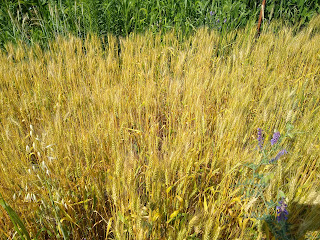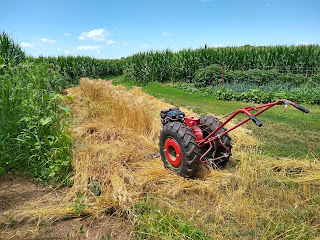The Farm Report
08-01-2022
WHEAT HARVEST
 |
This stuff, Annie! Johnny's Seeds happened to have Hard Durham Spring Wheat seeds in stock. |
 |
More time passed. If you look carefully, you can see the far end is still a little green. Wait. Wait. Wait. |
 |
This is my little daily test. I pop off a seed head and roll it in my hand like I was wadding up a piece of paper. |
 |
As the wheat berries - the actual grains - ripen and mature, they will release from their husks better and better each day. |
 |
The sickle bar mower on the front is just the ticket for cutting wheat. I just walked up and down the wheat patch mowing it off as I went. I walked up and back 3 times to get the whole field cut. |
 |
Not too long after, all the wheat and straw was lifted off the ground into the hauler. |
 |
I left a 'tail' of the tarp hanging so I could bring it up over the grain when I was finished. This helps keep all the good stuff where I want it. |
 |
Here's what makes it work inside. See the red weed whip 'strings'? The motor is underneath. |
 |
All set up ready to thrash. This is a little messy, and I'm greedy about getting ALL my wheat berries into the cannister for this winter's bread. |
 |
On mine, this is the 'just right' setting. Just on the mark between medium and full power. I set it just fast enough to knock off the hulls, but not fast enough to crack the wheat berries. |
 |
Like this. Push in the wheat, and the shredder does the rest. It feeds about as fast as you can bring it another handful of goodness. |
 |
'Taint all roses. See that ball of wheat straw down in there? Well, when you see that, it means it is time to replace the whip strings. |
 |
The machine is built to do that. It isn't difficult at all. I can change mine in under 10 minutes. |
 |
The shredder thrashes out the seeds from the husks and chops the straw into fine bits. |
 |
That whole load of wheat straw and berries took me only about an hour and a half to thrash. That includes set up and clean up time, too. It goes fast. |




















I’m pretty impressed with your threshing set up. I bet the quality is excellent. Brent
ReplyDeleteI sure hope so! Stay tuned and maybe I'll have a loaf for you when you drive by sometime this winter.
DeleteTim, too bad I didn’t know of your ideavor a couple of years ago. I threw away a decent old fanning mill with all the seives cause we were cleaning up an old farmstead that my son boughta lot of old tools and such got buried.
DeleteOh No!!!! Dang
DeleteAlways better to be lucky than smart, as they say! I discovered this by accident, but it works.
ReplyDeleteYou always deserve to be in the ribbons, far more than an Honorable Mention. Freshly ground flour makes the best bread; you are going to be living high on the hog!
ReplyDeleteI use one of my wife's tricks with the wheat. She knew that as soon as the wheat berry is cracked open, it begins to oxidize and get sour. So, she always kept a jar of wheat berries at hand. She - and now, I - put about 1/2 cup of fresh berries in a coffee mill and add that to the regular flour immediately after grinding, when we make a loaf. Delicious and sweet.
DeleteI'd say you get A++ for self-sufficiency and having loads of fun doing it. Seeing Annie supervise makes me smile. The bread at Oakdale Farm will be superlative!
ReplyDeleteAnnie is a hoot, no doubt. And just for the record, I do not have to pose her or set up her photo shoots. She's just always there ready to go.
Delete